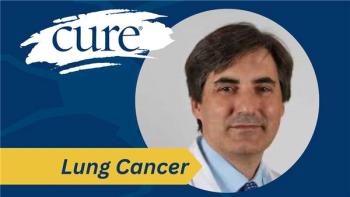
Tumor Treating Fields Improve Survival in Glioblastoma
Patients with glioblastoma multiforme (GBM) saw a 37 percent reduced risk of death and increased overall survival (OS) when treated with tumor treating fields (TTFields), according to a landmark analysis of the findings from the EF-14 trial.
Patients with glioblastoma multiforme (GBM) saw a 37 percent reduced risk of death and increased overall survival (OS) when treated with tumor treating fields (TTFields), according to a landmark analysis of the findings from the EF-14 trial.
Two-, three- four- and five-year overall and progression-free survival (PFS) rates for patients who received TTFields with adjuvant temozolomide were significantly improved over patients who received temozolomide alone, reported Roger Stupp, M.D., professor of neurological surgery at Northwestern University Feinberg School of Medicine and associate director for strategic initiatives at the Robert H. Lurie Comprehensive Cancer Center.
He deemed these findings a “clear improvement,” in a setting like GBM where the prognosis is so poor and thus requires a “thinking out of the box” strategy like TTFields. He said that this final analysis of EF-14 suggests that electric fields therapy should be considered as part of the standard of care for all patients with newly diagnosed GBM.
Stupp presented final results from the international, multicenter, phase 3 EF-14 trial during a press conference April 2 at the 2017 AACR Annual Meeting. Interim findings from EF-14, based on the experience of 315 patients, led to the FDA’s approval of the device in 2015 for use in combination with adjuvant temozolomide, as a treatment for patients with newly diagnosed GBM following surgery, chemotherapy, and radiation.
TTFields (Optune; Novocure) are low-intensity electric fields alternating at an intermediate frequency (200kHz) that are thought to exert anticancer effects by blocking cell division. For patients with GBM, the TTFields are delivered continuously to the brain by a patient-operated, medical device that is worn continuously (at least 18 hours) throughout the day.
Stupp said that patients learned how to use the device very quickly, and in his 10 years of experience studying it, he has found it to be well-tolerated. In EF-14, adherence was more than 75 percent over the course of a median number of 8.2 TTFields/temozolomide one-month cycles of therapy. Most of the side effects in the experimental arm he said were due to the chemotherapy rather than the device, which is associated with skin reactions that are usually mild.
The EF-14 trial enrolled patients from July 2009 to December 2014, and the findings reported at AACR were as of the data cutoff Dec. 28, 2016. A second-generation, lighter version of the device was approved by the FDA in July 2016, weighing 2.7 lbs or about half the size and weight of the original.
A total of 695 patients with grade IV GBM who had completed standard treatment involving surgery, temozolomide, and radiation, were randomized within seven weeks of their last radiation dose to either temozolomide with TTFields (466 patients) or temozolomide alone (229 patients). To be included in the study, participants had a Karnofsky performance score 70 or more, histologically proven WHO Grade 4 astrocytoma (glioblastoma, GBM), supratentorial tumor location, and nonprogressive disease. Patients were excluded if they demonstrated progressive disease per Macdonald criteria, infratentorial tumor location, and evidence of increased intracranial pressure.
Patient characteristics were similar between the two arms: median age in the two groups was approximately 56.5 years, and most patients were male (68.5 percent). The trial’s primary endpoint was progression-free survival (PFS) based on blinded central radiology review, with OS as the secondary endpoint.
PFS was 6.7 months with TTFields/temozolomide versus four months in the temozolomide-only arm. Median PFS after diagnosis was 11.2 months in the experimental arm compared with 7.8 months in the control group. Median OS was 20.9 months with TTFields versus 16.0 months with temozolomide only.
MGMT is a clinically significant molecular marker in this setting, and patients whose tumors have methylated MGMT generally have a better prognosis. In this trial, among the 41 percent of patients with methylated MGMT, OS was 31.6 months in the TTFields arm compared with 21.2 months for in the control group. For patients with unmethylated MGMT, the survival benefit with TTFields was shorter (16.9 months vs 14.7 months).
Notably, reported Stupp, OS was better with TTFields in patients irrespective of age, suggesting that oncologists should consider the device for use in elderly patients. Median OS was 21.6 months in patients aged younger than 65 years in the TTFields cohort, compared with 17.1 months with temozolomide alone; for patients aged 65 and older, median OS was 16.0 months with the device versus 10.9 months among control participants.
Stupp also reported landmark annual survival rates in patients using TTFields. One year after randomization, 73 percent of patients in the TTFields arm were alive versus 65 percent of the control participants. At year two, survival was 43 percent versus 31 percent, respectively; year three (26 percent vs 16 percent), year four (20 percent vs 8 percent) and five years out, 13 percent of patients with the device survived versus 5 percent with chemotherapy only. The investigators noted that patients who wore the device longer than 18 hours/day did have better outcomes.
Prior to temozolomide chemotherapy, five-year survival rates in GBM were 3.6 percent, Stupp remarked in his presentation. When temozolomide was added to radiation, five-year survival improved to 9.8 percent. Now, however, “EF-14 establishes a new landmark five-year survival rate of 13 percent, and long-term remission in GBM is now possible.”
“Although we’re far from where we want to be,” Stupp concluded, “TTFields confer a meaningful additional benefit for these patients,” with all subgroups benefitting from the therapy, including those with the worst prognosis.
He added that the device is being explored for use in treating other solid tumors, including pancreatic cancer and mesothelioma. “These data show the power of this new treatment modality, and we look forward to learning the results of trials testing it in patients with other forms of cancer.”





